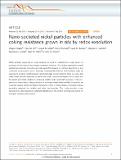Files in this item
Nano-socketed nickel particles with enhanced coking resistance grown in situ by redox exsolution
Item metadata
| dc.contributor.author | Neagu, Dragos | |
| dc.contributor.author | Oh, Tae-Sik | |
| dc.contributor.author | Miller, David Noel | |
| dc.contributor.author | Ménard, Hervé | |
| dc.contributor.author | Bukhari, Syed Munawer | |
| dc.contributor.author | Gamble, Stephen Richard | |
| dc.contributor.author | Gorte, Raymond J. | |
| dc.contributor.author | Vohs, John M. | |
| dc.contributor.author | Irvine, John Thomas Sirr | |
| dc.date.accessioned | 2015-09-11T12:10:03Z | |
| dc.date.available | 2015-09-11T12:10:03Z | |
| dc.date.issued | 2015-09-11 | |
| dc.identifier | 206145887 | |
| dc.identifier | 3d9974c7-dbce-4099-a2ef-c2f415434964 | |
| dc.identifier | 84941299768 | |
| dc.identifier | 000362949100008 | |
| dc.identifier.citation | Neagu , D , Oh , T-S , Miller , D N , Ménard , H , Bukhari , S M , Gamble , S R , Gorte , R J , Vohs , J M & Irvine , J T S 2015 , ' Nano-socketed nickel particles with enhanced coking resistance grown in situ by redox exsolution ' , Nature Communications , vol. 6 , 8120 , pp. 1-8 . https://doi.org/10.1038/ncomms9120 | en |
| dc.identifier.issn | 2041-1723 | |
| dc.identifier.other | ORCID: /0000-0002-8394-3359/work/68280731 | |
| dc.identifier.uri | https://hdl.handle.net/10023/7443 | |
| dc.description | DN thanks the European Project METSAPP (FCH JU-GA 278257) for funding. We also thank NSF and EPSRC for Materials World Network funding ref EP/J018414/1. | en |
| dc.description.abstract | Metal particles supported on oxide surfaces are used as catalysts for a wide variety of processes in the chemical and energy conversion industries. For catalytic applications, metal particles are generally formed on an oxide support by physical or chemical deposition, or less commonly by exsolution from it. Although fundamentally different, both methods might be assumed to produce morphologically and functionally similar particles. Here we show that unlike nickel particles deposited on perovskite oxides, exsolved analogues are socketed into the parent perovskite, leading to enhanced stability and a significant decrease in the propensity for hydrocarbon coking, indicative of a stronger metal–oxide interface. In addition, we reveal key surface effects and defect interactions critical for future design of exsolution-based perovskite materials for catalytic and other functionalities. This study provides a new dimension for tailoring particle–substrate interactions in the context of increasing interest for emergent interfacial phenomena. | |
| dc.format.extent | 8 | |
| dc.format.extent | 7168738 | |
| dc.language.iso | eng | |
| dc.relation.ispartof | Nature Communications | en |
| dc.subject | QD Chemistry | en |
| dc.subject | DAS | en |
| dc.subject | BDC | en |
| dc.subject | R2C | en |
| dc.subject.lcc | QD | en |
| dc.title | Nano-socketed nickel particles with enhanced coking resistance grown in situ by redox exsolution | en |
| dc.type | Journal article | en |
| dc.contributor.sponsor | European Commission | en |
| dc.contributor.sponsor | EPSRC | en |
| dc.contributor.sponsor | EPSRC | en |
| dc.contributor.sponsor | EPSRC | en |
| dc.contributor.sponsor | EPSRC | en |
| dc.contributor.institution | University of St Andrews. School of Chemistry | en |
| dc.contributor.institution | University of St Andrews. EaSTCHEM | en |
| dc.identifier.doi | 10.1038/ncomms9120 | |
| dc.description.status | Peer reviewed | en |
| dc.identifier.url | https://www.nature.com/articles/ncomms9120#Sec13 | en |
| dc.identifier.grantnumber | en | |
| dc.identifier.grantnumber | EP/J018414/1 | en |
| dc.identifier.grantnumber | EP/K031252/1 | en |
| dc.identifier.grantnumber | EP/K015540/1 | en |
| dc.identifier.grantnumber | EP/K039210/1 | en |
This item appears in the following Collection(s)
Items in the St Andrews Research Repository are protected by copyright, with all rights reserved, unless otherwise indicated.

